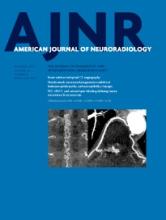Abstract
BACKGROUND AND PURPOSE: Good CTA collaterals independently predict good outcome in acute ischemic stroke. Our aim was to evaluate the role of collateral circulation and its added benefit over CTP-derived total ischemic volume as a predictor of baseline NIHSS score, total ischemic volume, hemorrhagic transformation, final infarct size, and a modified Rankin Scale score >2.
MATERIALS AND METHODS: This was a retrospective study of 395 patients with stroke dichotomized by recanalization (recanalization positive/recanalization negative) and collateral status. Clot burden score was quantified on baseline CTA. Total ischemic volumes were derived from thresholded CTP maps. Final infarct size was assessed on follow-up CT/MRI. We performed uni-/multivariate analyses for each outcome, adjusting for rtPA status, using general linear (continuous variables) and logistic (binary variables) regression. Model comparison with collateral score and total ischemic volume was performed using the F or likelihood ratio test.
RESULTS: Collateral presence independently and inversely predicted all outcomes except hemorrhagic transformation in patients who were recanalization negative and mRS >2 in patients who were recanalization positive. The greatest collateral benefit occurred in patients who were recanalization negative, contributing 16.5% and 19.2% of the variability for final infarct size and mRS >2. The collateral score model is superior to the total ischemic volume for mRS >2 prediction, but a combination of total ischemic volume and collateral score is superior for mRS >2 and final infarct prediction (24% and 28% variability, respectively). In patients who were recanalization positive, a model including collateral score and total ischemic volume was superior to that of total ischemic volume for hemorrhagic transformation and final infarct prediction but was muted compared with patients who were recanalization negative (11.3% and 16.9% variability).
CONCLUSIONS: Collateral circulation is an independent predictor of all outcomes, but the magnitude of significance varies, greater in patients who were recanalization negative versus recanalization positive. Total ischemic volume assessment is complementary to collateral score in many cases.
ABBREVIATIONS:
- CBS
- clot burden score
- CS
- collateral score
- HT
- hemorrhagic transformation
- R+
- recanalization positive
- R−
- recanalization negative
- TIV
- total ischemic volume
- bNIHSS
- baseline NIHSS score
- © 2015 by American Journal of Neuroradiology












